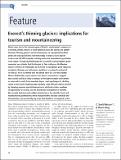Everest's thinning glaciers : implications for tourism and mountaineering
Abstract
Glacier mass loss in the Everest region of Nepal is accelerating in response to a warming climate, which is a trend observed across the central and eastern Himalaya. Thinning glaciers and the development of supraglacial (surface) ponds and large glacial lakes will increasingly restrict access to glacier surfaces and will affect popular trekking routes and mountaineering activities in the region. Through quantifying glacier accessibility and supraglacial pond expansion, we estimate that the Kongma La Pass trail across the Khumbu Glacier is likely to be impassable by 2020 due to supraglacial pond expansion and glacier thinning, and will require significant re-routing. An estimated 197 649 227 m3 of ice melted over the period 1984–2015 on the Khumbu Glacier. Additionally, expert opinion from Everest mountaineers suggest that rockfall activity is likely to increase in the high-mountain environment as snow and ice melts from mountain slopes, requiring changes to climbing routes on the world's highest peaks. Similarly, route difficulty will be affected by changing monsoon precipitation patterns, which determines windows of opportunity for ascents, and the distribution and quantity of snowfall. We conclude that increased collaboration between the scientific, local, and mountaineering communities offers mutual benefits for data collection and dissemination, and we identify key areas that should be investigated further.
Citation
Watson , C S & King , O 2018 , ' Everest's thinning glaciers : implications for tourism and mountaineering ' Geology Today , vol. 34 , no. 1 , pp. 18-25 . https://doi.org/10.1111/gto.12215
Publication
Geology Today
ISSN
0266-6979Type
Journal article
Description
C.S.W acknowledges support: the Mount Everest Foundation, the British Society for Geomorphology, the Royal Geographical Society (with IBG), the Petzl Foundation, and water@leeds. O.K. is a recipient of a NERC DTP PhD studentship.Collections
Items in the St Andrews Research Repository are protected by copyright, with all rights reserved, unless otherwise indicated.

